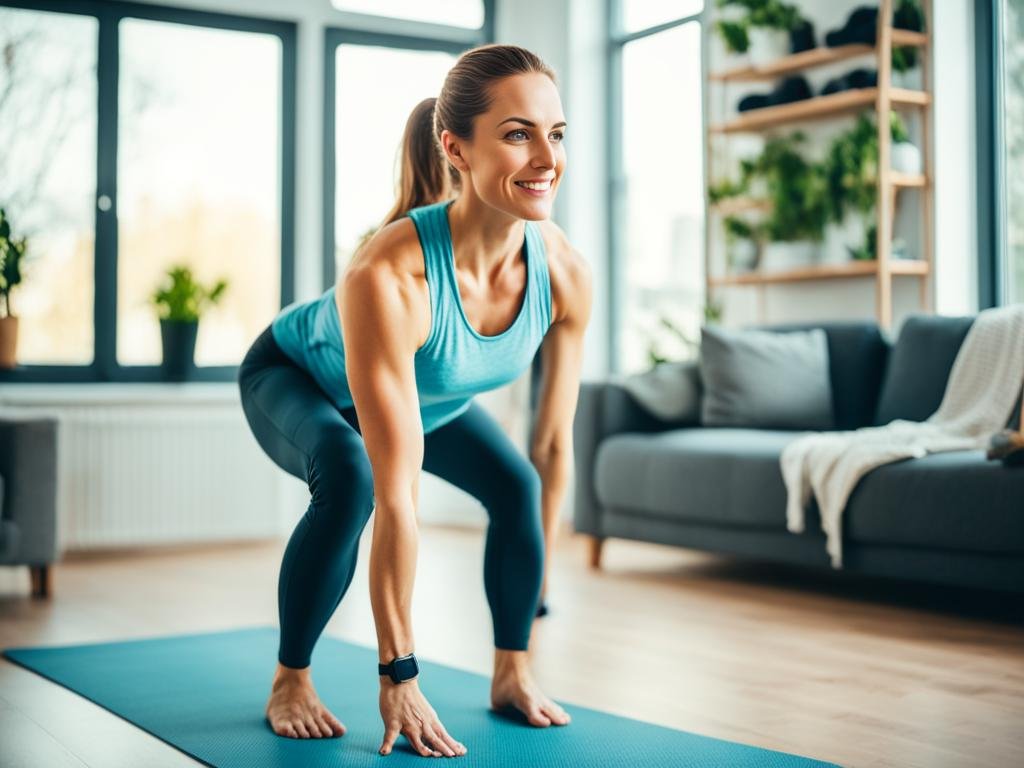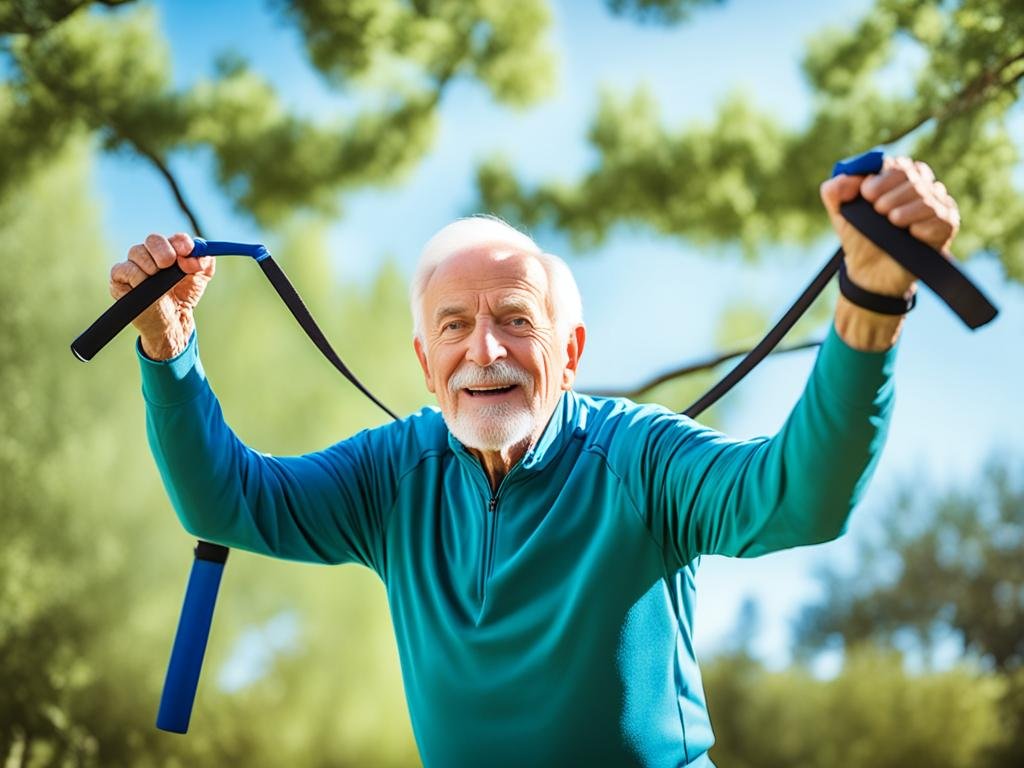Defining Your Fitness Goals
Establishing clear and specific fitness goals is crucial for staying motivated and tracking progress. Experts recommend focusing on immediate, tangible benefits like stress reduction and increased energy, rather than just long-term goals like weight loss or improved appearance. By aligning your fitness goals with your personal values and daily life, you are more likely to make exercise a sustainable habit.
When setting your fitness goals, consider the following strategies:
- Start with specific and measurable goals. For example, “I will jog for 30 minutes, three times a week,” or “I will lift weights for 45 minutes, twice a week.”
- Set achievable goals that challenge you, but are still within reach. Setting unrealistic goals can lead to discouragement and burnout.
- Focus on process goals, such as forming a habit or improving your technique, rather than just outcome goals like weight loss or muscle gain.
- Prioritize intrinsic motivators, like improved mental health or increased energy, over extrinsic motivators, such as physical appearance or societal pressures.
- Review and adjust your goals regularly as your fitness level and priorities change.
By defining clear, personalized fitness goals, you can stay motivated, measure your progress, and make exercise a sustainable part of your lifestyle.
“The secret of getting ahead is getting started. The secret of getting started is breaking your complex, overwhelming tasks into small, manageable tasks, and then starting on the first one.” – Mark Twain

| Goal Type | Example | Benefits |
|---|---|---|
| Specific and Measurable | Run 5K in under 30 minutes | Provides clear targets to work towards and track progress |
| Achievable | Increase steps by 2,000 per day | Promotes motivation and long-term consistency |
| Process-oriented | Establish a daily 30-minute workout routine | Focuses on habit formation for sustainable change |
| Intrinsically Motivated | Improve sleep quality and mental well-being | Aligns with personal values and priorities |
Creating a Balanced Exercise Routine
To achieve optimal fitness, it’s essential to incorporate a well-rounded exercise routine that targets different aspects of physical health. This includes a combination of aerobic exercise, strength training, and flexibility training. By diversifying your workout regimen, you can improve your cardiovascular fitness, build and maintain muscle mass, and enhance your overall mobility and range of motion.
Incorporating Aerobic, Strength, and Flexibility Training
Aerobic exercise, such as walking, swimming, or cycling, is crucial for improving heart health and increasing endurance. These activities raise your heart rate and challenge your cardiovascular system, leading to improved blood circulation and respiratory function.
Strength training, on the other hand, helps build and maintain muscle mass, which is essential for supporting bone health and overall physical function. Exercises like resistance training, weightlifting, or bodyweight exercises can be incorporated into your routine to target different muscle groups and promote muscular strength and endurance.
Flexibility training, such as stretching or yoga, plays a vital role in enhancing your range of motion, reducing the risk of injury, and improving your overall physical well-being. Dedicating time to flexibility exercises can help you maintain a healthy and balanced exercise routine.
“The key to a well-rounded exercise routine is to find the right balance between aerobic, strength, and flexibility training. This will ensure that you’re addressing all aspects of your physical fitness and reaping the maximum benefits from your workouts.”
Experts recommend gradually incorporating all three types of exercise into your routine, gradually increasing the intensity and duration as you become more comfortable and capable. This will help you achieve a balanced exercise routine that supports your overall health and fitness goals.
| Exercise Type | Benefits | Examples |
|---|---|---|
| Aerobic Exercise | Improves cardiovascular health, increases endurance | Walking, Swimming, Cycling |
| Strength Training | Builds and maintains muscle mass, supports bone health | Resistance Training, Weightlifting, Bodyweight Exercises |
| Flexibility Training | Enhances range of motion, reduces injury risk | Stretching, Yoga |
Getting Started: Tips for Beginners
Embarking on a fitness journey can be daunting, especially for those new to exercise. However, with the right approach, fitness for beginners can be an achievable and rewarding experience. The key is to start slowly and build up gradually, allowing your body to adapt and progress at a comfortable pace.
Starting Slowly and Building Up Gradually
When starting exercise, it’s important to begin with moderate-intensity activities that are gentle on your body. Activities like brisk walking, swimming, or light cycling are excellent options for fitness for beginners. Start with shorter sessions, such as 10-15 minutes, and gradually increase the duration and frequency of your workouts over time.
- Begin with low-impact exercises that are easy on your joints, such as walking, swimming, or cycling.
- Start with shorter sessions (10-15 minutes) and gradually increase the duration and frequency of your workouts.
- Allow for proper warm-up and cool-down periods to prepare your body and prevent injury.
- Listen to your body’s cues and don’t push yourself too hard, especially in the early stages of your exercise progression.
Incorporating strength training and flexibility exercises is also important for a balanced fitness for beginners routine. Begin with bodyweight exercises or light resistance training, and focus on proper form to build a solid foundation before gradually increasing the intensity.
“The secret of getting ahead is getting started. The secret of getting started is breaking your complex overwhelming tasks into small manageable tasks, and then starting on the first one.”
– Mark Twain
Remember, the key to long-term success is to be patient and consistent. Fitness for beginners is a journey, and by starting exercise gradually and exercise progression, you’ll be well on your way to a healthier, more active lifestyle.

Making Physical Fitness a Habit
Establishing an exercise habit and incorporating physical activity into your daily routine is crucial for maintaining a healthy lifestyle. Building a consistent daily exercise practice can be challenging, but with the right strategies, it can become a seamless part of your daily life.
Incorporating Exercise into Your Daily Routine
The key to making physical fitness a habit is to find ways to integrate it into your existing daily activities. Here are some tips to help you get started:
- Schedule your exercise sessions: Treat your physical activity like any other important appointment and block off time in your calendar.
- Combine exercise with other tasks: For example, try walking or cycling to work, taking the stairs instead of the elevator, or doing bodyweight exercises during your lunch break.
- Incorporate physical activity into your daily commute: If you live close enough, consider walking or biking to work. If not, park farther away or get off the bus or train a stop earlier to increase your daily step count.
- Find opportunities to move throughout the day: Set reminders to take short breaks and go for a quick walk or do some stretches at your desk.
Consistency is key when it comes to building an exercise habit. Avoid skipping sessions, as this can make it harder to maintain the routine. Remember, even small changes can have a significant impact on your overall physical activity levels and long-term health.
| Tip | Description |
|---|---|
| Schedule your exercise | Block off time in your calendar for your exercise sessions and treat them as important appointments. |
| Combine exercise with other tasks | Find ways to integrate physical activity into your daily routine, such as walking or cycling to work. |
| Incorporate activity into your commute | If possible, walk, bike, or take public transportation to increase your daily exercise levels. |
| Move throughout the day | Set reminders to take breaks and engage in short bursts of physical activity during the day. |
“The secret of getting ahead is getting started. The secret of getting started is breaking your complex overwhelming tasks into small manageable tasks, and then starting on the first one.”
– Mark Twain
By implementing these strategies, you can gradually build an exercise habit and make physical fitness a natural part of your daily life. Remember, consistency is key, and it may take time to establish a sustainable physical activity routine. Stick with it, and you’ll reap the rewards of improved health, energy, and overall well-being.
Staying Motivated and Overcoming Obstacles
Maintaining exercise motivation can be a real challenge, especially when faced with setbacks or competing priorities. However, experts suggest focusing on the immediate, positive benefits of physical activity, such as stress reduction and increased energy, rather than solely on long-term goals. Having a solid support system, whether it’s friends, family, or a fitness community, can also be invaluable in helping you stay accountable and motivated.
When obstacles arise, it’s crucial to be kind to yourself and adjust your routine as needed, rather than giving up entirely. Fitness challenges can take many forms, from injuries to lack of time or energy. The key is to approach these hurdles with a flexible and adaptable mindset, making modifications to your exercise plan as necessary.
One effective strategy for overcoming obstacles is to break down your fitness goals into smaller, more manageable steps. This can help you celebrate small victories along the way, which can be a powerful source of exercise motivation. Additionally, seeking support from a personal trainer or joining a fitness community can provide the accountability and guidance needed to push through difficult times.
Remember, the journey to improved physical fitness is not always linear. Setbacks and challenges are a natural part of the process. The most important thing is to maintain a positive attitude, stay flexible, and keep moving forward, no matter what fitness challenges come your way.
“The only way to overcome the obstacles in your life is to confront them head-on. Embrace the challenge, and watch your exercise motivation soar.”

By prioritizing self-care, celebrating small wins, and building a supportive network, you can stay motivated and overcome any fitness challenges that arise. With a little creativity and determination, you can unlock the full benefits of a physically active lifestyle.
Tracking and Monitoring Your Progress
Regularly tracking and monitoring your fitness progress can be a game-changer when it comes to reaching your health and wellness goals. By closely monitoring key metrics like heart rate, distance covered, and strength gains, you can gain valuable insights into your fitness journey and make informed adjustments to your routine as needed.
One of the most effective ways to track your fitness tracking and progress monitoring is by utilizing fitness trackers and apps. These innovative tools can provide you with a wealth of data, allowing you to closely follow your goal tracking and ensure you’re making steady progress towards your objectives.
However, experts also emphasize the importance of regularly assessing your progress through more subjective means, such as how you feel before and after workouts. This can help you better understand the impact of your efforts and identify any areas that may need more attention or adjustment.
“Consistent tracking and monitoring are essential for maintaining motivation and achieving your fitness goals. It’s not just about the numbers, but also how your body and mind are responding to your exercise routine.”
By combining the power of data-driven tracking with a more holistic understanding of your progress, you can create a well-rounded approach to fitness that keeps you engaged, motivated, and on the path to long-term success.
Key Strategies for Effective Progress Monitoring
- Utilize fitness trackers and apps to monitor metrics like heart rate, distance, and strength gains.
- Regularly assess how you feel before and after workouts to gauge the impact of your routine.
- Adjust your exercise program as needed to continue challenging yourself and driving progress.
- Celebrate your achievements and milestones to stay motivated and engaged with your fitness journey.
By embracing a comprehensive approach to fitness tracking, progress monitoring, and goal tracking, you’ll be well on your way to unlocking your full potential and feeling your best both physically and mentally.
Physical Fitness for Different Age Groups
Maintaining physical fitness is essential throughout our lives, but the specific needs and recommendations can vary based on our age and life stage. When it comes to fitness for older adults, the focus shifts towards exercises that help preserve muscle mass, bone density, and balance to reduce the risk of falls.
Exercises for Older Adults
As we age, strength training becomes increasingly important to counteract the natural decline in muscle mass and bone density. Experts recommend that older adults incorporate resistance exercises, such as weight lifting or using resistance bands, into their fitness routines at least two to three times per week.
In addition to strength training, balance exercises are crucial for older adults. Activities like Tai Chi, standing on one foot, and heel-to-toe walks can help improve stability and reduce the risk of falls, which can have serious consequences for seniors. These exercises should be performed regularly, ideally several times per week.
| Exercise Type | Benefits for Older Adults | Recommended Frequency |
|---|---|---|
| Strength Training | Maintains muscle mass and bone density | 2-3 times per week |
| Balance Exercises | Improves stability and reduces fall risk | Several times per week |
It’s important for older adults to consult with their healthcare providers when starting a new exercise routine, as they may have specific medical conditions or limitations that need to be considered. By incorporating a balanced fitness regimen, seniors can maintain their physical independence and overall well-being.

“Staying physically active is one of the most important things older adults can do to maintain their health and independence.”
Incorporating physical fitness into Your Lifestyle
Integrating fitness into your everyday life is the key to maintaining a healthy and active lifestyle. By finding creative ways to incorporate physical activity into your daily routines, you can make fitness a sustainable part of your lifestyle. This not only benefits your overall health but also helps you stay motivated and engaged with your fitness goals.
One effective strategy is to integrate fitness into your transportation. Instead of relying solely on cars or public transport, consider walking or cycling to work, running errands, or visiting friends and family. This allows you to integrate fitness into your daily physical activity and reduces your carbon footprint.
Another way to incorporate lifestyle fitness is by taking exercise breaks during the workday. Whether it’s a brisk walk around the office, a quick stretch session, or a short workout in a private space, these mini-breaks can help you stay energized, focused, and dedicated to your fitness journey.
Additionally, finding physical activities that you genuinely enjoy and can do with friends or family can make daily physical activity a natural part of your lifestyle. Joining a sports team, taking a dance class, or exploring outdoor recreational activities are all great ways to integrate fitness into your social life.
By prioritizing exercise and making it a seamless part of your daily routines, you can transform your lifestyle into one that supports your fitness goals. This holistic approach to integrating fitness ensures that it becomes a sustainable and enjoyable aspect of your life, rather than a chore or a temporary fix.
| Strategies for Integrating Fitness into Your Lifestyle | Benefits |
|---|---|
|
|
“Fitness is not about being better than someone else… It’s about being better than you used to be.”
By embracing these strategies and making fitness a natural part of your daily life, you can transform your lifestyle into one that supports your overall health and well-being. Remember, the key is to find ways to integrate fitness into your existing routines and activities, making it a sustainable and enjoyable part of your lifestyle.
Conclusion
Achieving and maintaining physical fitness can have a profound impact on your overall health and well-being. By setting realistic physical fitness summary goals, creating a balanced exercise routine, and finding ways to make physical activity a sustainable habit, you can boost your energy, reduce your risk of chronic diseases, and improve your quality of life.
Remember to start slowly, be kind to yourself, and find wellness tips activities you genuinely enjoy to make fitness a lifelong journey. Incorporating regular exercise into your lifestyle can provide a wealth of health benefits of exercise, from better cardiovascular health to increased strength and flexibility.
Whether you’re just starting your fitness journey or looking to take your routine to the next level, the key is to stay motivated, celebrate your progress, and continuously adapt your approach to meet your evolving needs and preferences. By making physical fitness a priority, you’ll unlock the path to a healthier, more vibrant life.
FAQ
What are the benefits of regular physical activity?
Regular physical activity provides numerous health benefits, including reducing the risk of long-term diseases, improving balance and coordination, aiding in weight loss, and boosting sleep and self-esteem.
What are the common barriers to staying physically active?
Many people face barriers to staying active, such as lack of time, fatigue, and depression. Experts emphasize the importance of finding activities you enjoy, setting realistic goals, and having a support system to help maintain motivation and overcome obstacles.
How can I set effective fitness goals?
Establishing clear and specific fitness goals is crucial for staying motivated and tracking progress. Experts recommend focusing on immediate, tangible benefits like stress reduction and increased energy, rather than just long-term goals like weight loss or improved appearance.
What should a well-rounded fitness program include?
A well-rounded fitness program should include a combination of aerobic, strength, and flexibility exercises. Aerobic activities improve cardiovascular health, while strength training helps maintain muscle mass and bone density, and flexibility exercises promote mobility and reduce the risk of injury.
How should I start an exercise routine as a beginner?
For those new to exercise, it’s important to start slowly and build up gradually to avoid burnout or injury. Experts suggest beginning with moderate-intensity activities like brisk walking or swimming, and gradually increasing the duration and frequency of your workouts over time.
How can I make physical activity a sustainable habit?
Turning physical activity into a sustainable habit requires planning and consistency. Experts recommend scheduling exercise into your daily routine, finding ways to combine exercise with other tasks, and making it a natural part of your lifestyle.
How can I stay motivated to exercise?
Maintaining motivation can be a challenge, especially when faced with setbacks or competing priorities. Experts suggest focusing on immediate, positive benefits of exercise, such as stress reduction and increased energy, and having a support system to help you stay accountable and motivated.
How can I track and monitor my fitness progress?
Regularly tracking and monitoring your fitness progress can help keep you motivated and ensure you’re making progress towards your goals. This can include measuring metrics like heart rate, distance, and strength, as well as tracking how you feel before and after workouts.
What are the specific fitness needs and recommendations for older adults?
For older adults, experts emphasize the importance of incorporating strength training to maintain muscle mass and bone density, as well as balance exercises to reduce the risk of falls. Activities like Tai Chi, standing on one foot, and heel-to-toe walks can help improve balance and mobility.
How can I incorporate physical fitness into my daily lifestyle?
Making physical fitness a sustainable part of your lifestyle requires finding ways to incorporate it into your daily routines and activities, such as walking or cycling for transportation, taking exercise breaks during the workday, and finding physical activities you enjoy that you can do with friends or family.

